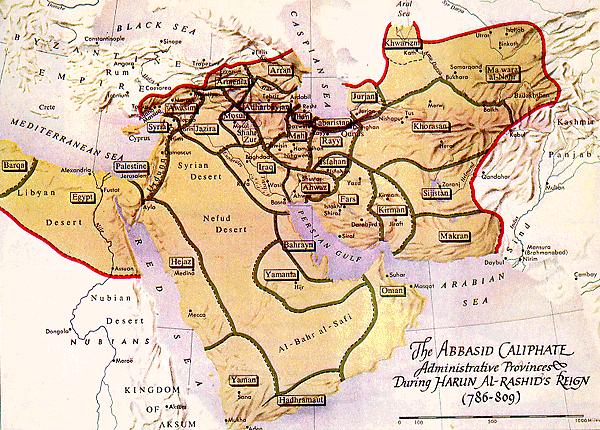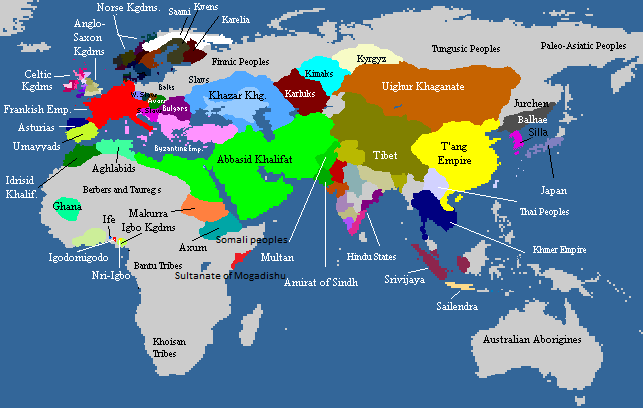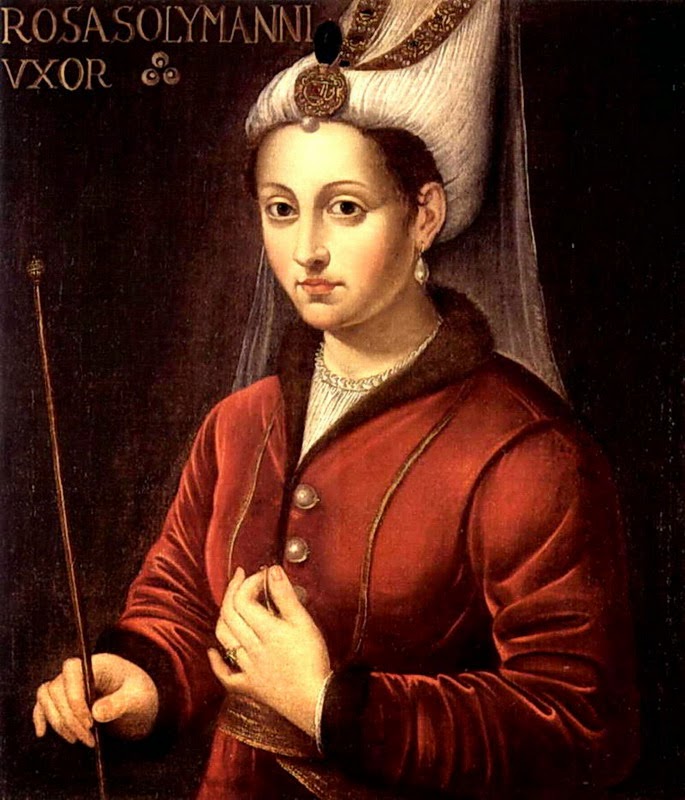|
Marajil
Marājil (; d. 786) was an umm walad of caliph Harun al-Rashid and mother of caliph al-Ma'mun. Biography Marajil was a Persian slave concubine of Abbasid prince Harun (future Caliph Harun al-Rashid). According to one account, she had entered the Abbasid household as a prisoner of war. Marajil was raised in the Abbasid household before being given as a concubine to prince Harun. She was one or two years younger than Harun. Marajil's only child, Abdallah (the future al-Ma'mun), was born in Baghdad on the night of the 13 to 14 September 786 CE to Harun al-Rashid and his concubine Marajil, from Badghis. On the same night, which later became known as the "night of the three caliphs", his uncle Al-Hadi died and was succeeded by Ma'mun's father, Harun al-Rashid, as ruler of the Abbasid Caliphate. Harun became caliph in 786 when he was in his early twenties. At the time, he was tall, good looking, and slim but strongly built, with wavy hair and olive skin. Upon his accession, Harun l ... [...More Info...] [...Related Items...] OR: [Wikipedia] [Google] [Baidu] [Amazon] |
Al-Ma'mun
Abū al-ʿAbbās Abd Allāh ibn Hārūn al-Maʾmūn (; 14 September 786 – 9 August 833), better known by his regnal name al-Ma'mun (), was the seventh Abbasid caliph, who reigned from 813 until his death in 833. His leadership was marked by the power and prosperity of the Abbasid Caliphate, al-Ma'mun promoted the Graeco-Arabic translation movement, the House of Wisdom, flowering of learning and the sciences in Baghdad, and the publishing of al-Khwarizmi's The Compendious Book on Calculation by Completion and Balancing, book now known as "Algebra". Making him one of the most important caliphs in the Islamic Golden Age. He is also known as a proponent of the rational Islamic theology of Mu'tazilism. Al-Ma'mun succeeded his half-brother al-Amin after a Fourth Fitna, civil war, much of his reign was spent on peace campaigns. His strong support for Mu'tazilism led him to imprison a Sunni Islam, Sunni Imam, Ahmad ibn Hanbal in an event that became known as ''mihna.'' Al-Ma'mun's for ... [...More Info...] [...Related Items...] OR: [Wikipedia] [Google] [Baidu] [Amazon] |
Zubaidah Bint Ja`far
Zubaidah bint Ja`far ibn al-Mansur () (died 26 Jumada I 216 AH / 10 July 831 CE) was the best known of the Abbasid princesses, and the wife and double cousin of Harun al-Rashid. She is particularly remembered for the series of wells, reservoirs and artificial pools that provided water for Muslim pilgrims along the route from Baghdad to Mecca and Medina, which was renamed the Darb Zubaidah in her honor. The exploits of her and her husband, Harun al-Rashid, form part of the basis for '' The Thousand and One Nights''. Biography Zubaidah's birthdate is unknown; it is known that she was at least a year younger than Harun. Her father, Ja'far was a brother of the Abbasid caliph al-Mahdi. Her mother, Salsal, was an elder sister of al-Khayzuran, second and most powerful wife of al-Mahdi, and mother of the future caliphs Musa al-Hadi and Harun al-Rashid. Zubaidah is a pet name, given by her grandfather, caliph al-Mansur. The name means "little butter ball". Zubaidah's real name at birth ... [...More Info...] [...Related Items...] OR: [Wikipedia] [Google] [Baidu] [Amazon] |
Harun Al-Rashid
Abū Jaʿfar Hārūn ibn Muḥammad ar-Rāshīd (), or simply Hārūn ibn al-Mahdī (; or 766 – 24 March 809), famously known as Hārūn al-Rāshīd (), was the fifth Abbasid caliph of the Abbasid Caliphate, reigning from September 786 until his death in March 809. His reign is traditionally regarded to be the beginning of the Islamic Golden Age. His epithet ''al-Rashid'' translates to "the Just", "the Upright", or "the Rightly-Guided". Harun established the legendary library Bayt al-Hikma ("House of Wisdom") in Baghdad in present-day Iraq, and during his rule Baghdad began to flourish as a world center of knowledge, culture and trade. During his rule, the family of Barmakids, which played a deciding role in establishing the Abbasid Caliphate, declined gradually. In 796, he moved his court and government to Raqqa in present-day Syria. Domestically, Harun pursued policies similar to those of his father Al-Mahdi. He released many of the Umayyads and 'Alids his brother Al ... [...More Info...] [...Related Items...] OR: [Wikipedia] [Google] [Baidu] [Amazon] |
Abbasid Caliph
The Abbasid caliphs were the holders of the Islamic title of caliph who were members of the Abbasid dynasty, a branch of the Quraysh tribe descended from the uncle of the Islamic prophet Muhammad, Al-Abbas ibn Abd al-Muttalib. The family came to power in the Abbasid Revolution in 748–750, supplanting the Umayyad Caliphate. They were the rulers of the Abbasid Caliphate, as well as the generally recognized ecumenical heads of Islam, until the 10th century, when the Shi'a Fatimid Caliphate (established in 909) and the Caliphate of Córdoba (established in 929) challenged their primacy. The political decline of the Abbasids had begun earlier, during the Anarchy at Samarra (861–870), which accelerated the fragmentation of the Muslim world into autonomous dynasties. The caliphs lost their temporal power in 936–946, first to a series of military strongmen and then to the Shi'a Buyid Emirs that seized control of Baghdad; the Buyids were in turn replaced by the Sunni Seljuk Tur ... [...More Info...] [...Related Items...] OR: [Wikipedia] [Google] [Baidu] [Amazon] |
Ustadh Sis
Ustadh Sis (also spelled: Ustad Sis, or Ostad Sis, ) was a Persian heresiarch and anti-Abbasid rebel leader. It is speculated that he was once a governor of Khorasan and possibly father to Al-Ma'mun’s Iranian mother, Marajil, which would make him Ma'mūn's maternal grandfather. Based in the eastern fringe of Khorasan, in the mid-8th-century he claimed he was a prophet of God and managed to gain followers among the villagers in that area. Many were previously followers of Bihafarid, whom the Abbasid commander, Abu Muslim, had crushed militarily. Reinvigoration of Bihafarid's movement Ustadh Sis launched a rebellion in 767, purportedly with 300,000 fighting men. His initial base was the mountainous region of Badghis, and he soon occupied Herat and Sistan before marching towards Merv. He initially defeated an Abbasid army under the command of al-Ajtham of Merv, but was then defeated in a bloody battle against an army led by Muhammad ibn Abdallah, the son of th ... [...More Info...] [...Related Items...] OR: [Wikipedia] [Google] [Baidu] [Amazon] |
786 Deaths
__NOTOC__ Year 786 (Roman numerals, DCCLXXXVI) was a common year starting on Sunday of the Julian calendar, the 786th year of the Common Era (CE) and Anno Domini (AD) designations, the 786th year of the 1st millennium, the 86th year of the 8th century, and the 7th year of the 780s decade. The denomination 786 for this year has been used since the early medieval period, when the Anno Domini calendar era became the prevalent method in Europe for naming years. Events By place Europe * King Charles the Younger, son of Charlemagne and ruler of Aquitaine, visits Monte Cassino and Capua, both in Duchy of Benevento, Beneventan territory. Prince Arechis II of Benevento, Arechis II, feeling threatened by the Franks, decides that he needs to stop quarrelling with the Byzantine Duchy of Naples so he can focus on the Frankish foe. Prince Arechis II therefore signs a peace agreement, or 'pactum', with the Duchy of Naples. Britain * Cyneheard the Ætheling, Cyneheard, brother of t ... [...More Info...] [...Related Items...] OR: [Wikipedia] [Google] [Baidu] [Amazon] |
Abbasid Harem
The harem of the caliphs of the Abbasid Caliphate (750–1258) in Baghdad was composed of their mothers, wives, slave concubines, female relatives and slave servants (women and eunuchs), occupying a secluded portion of the Abbasid household. This institution played an important social function within the Abbasid court and was that part were the women were confined and secluded. The senior woman in rank in the harem was the mother of the Abbasid caliph, Caliph. The Abbasid harem acted as a role model for the harems of other Islamic dynasties, as it was during the Abbasid Caliphate that the harem system was fully enforced in the Muslim world. Background and origin The harem system first became fully institutionalized in the Islamic world under the Abbasid caliphate. Although the term ''harem'' does not denote women's quarters in the Quran, a number of Quranic verses discussing modesty and seclusion were held up by Quranic commentators as religious rationale for the s ... [...More Info...] [...Related Items...] OR: [Wikipedia] [Google] [Baidu] [Amazon] |
Umm Walad
In the Muslim world, the title of ''umm al-walad'' () was given to a Concubinage in Islam, slave-concubine who had given birth to a child acknowledged by her master as his. These women were regarded as property and could be sold by their owners, a practice that was permitted at the time under regulations from Prophet Muhammad. After Muhammad’s death, Umar authorized a policy during his time as a caliph, that prohibited owners from selling or gifting their ''umm al-walads'', and upon their owners deaths, they would be granted freedom. Ali, Muhammad's cousin and son-in-law, initially concurred with Umar's decision. However, after Umar's death and the death of Uthman, who maintained the policy, Ali reversed it in the later period of his caliphate, declaring that ''umm al-walad'' was still sellable despite having given birth to the owner's child. Ali's viewpoint was eventually integrated into Shia Islam, Shi'ism, along with the acceptance of Nikah mut'ah, temporary marriages. On ... [...More Info...] [...Related Items...] OR: [Wikipedia] [Google] [Baidu] [Amazon] |
8th-century Slaves
The 8th century is the period from 701 (represented by the Roman numerals DCCI) through 800 (DCCC) in accordance with the Julian Calendar. In the historiography of Europe the phrase the long 8th century is sometimes used to refer to the period of circa AD 660–820. The coast of North Africa and the Iberian Peninsula quickly came under Islamic Arab domination. The westward expansion of the Umayyad Empire was famously halted at the siege of Constantinople by the Byzantine Empire and the Battle of Tours by the Franks. The tide of Arab conquest came to an end in the middle of the 8th century.Roberts, J., '' History of the World'', Penguin, 1994. In Europe, late in the century, the Vikings, seafaring peoples from Scandinavia, begin raiding the coasts of Europe and the Mediterranean, and go on to found several important kingdoms. In Asia, the Pala Empire is founded in Bengal. The Tang dynasty reaches its pinnacle under Chinese Emperor Xuanzong. The Nara period begins in Japan ... [...More Info...] [...Related Items...] OR: [Wikipedia] [Google] [Baidu] [Amazon] |
8th-century Women From The Abbasid Caliphate
The 8th century is the period from 701 (represented by the Roman numerals DCCI) through 800 (DCCC) in accordance with the Julian Calendar. In the historiography of Europe the phrase the long 8th century is sometimes used to refer to the period of circa AD 660–820. The coast of North Africa and the Iberian Peninsula quickly came under Islamic Arab domination. The westward expansion of the Umayyad Empire was famously halted at the siege of Constantinople by the Byzantine Empire and the Battle of Tours by the Franks. The tide of Arab conquest came to an end in the middle of the 8th century.Roberts, J., '' History of the World'', Penguin, 1994. In Europe, late in the century, the Vikings, seafaring peoples from Scandinavia, begin raiding the coasts of Europe and the Mediterranean, and go on to found several important kingdoms. In Asia, the Pala Empire is founded in Bengal. The Tang dynasty reaches its pinnacle under Chinese Emperor Xuanzong. The Nara period begins in ... [...More Info...] [...Related Items...] OR: [Wikipedia] [Google] [Baidu] [Amazon] |






